
 The electric car has had a rough history in the last 100 years. Hell, the battle we are seeing now was fought out over 100 years ago. The introduction of the motor carriage opened up a new opportunity for an array of drivetrains. There was a time when steam, electricity, gasoline, and even some gas/electric hybrids (Porsche, see left) fought for supremacy in automobile motivation, and it’s easy to see who won out. Gas was cheap, plentiful and very, very powerful. Not only that, but it also was quick to refuel, and as long as there was a supply of fuel the gasoline car could go anywhere. However, the electric car was left in the dust- there were severe limitations to its range and our electric infrastructure was no where ready to supply power where needed.
The electric car has had a rough history in the last 100 years. Hell, the battle we are seeing now was fought out over 100 years ago. The introduction of the motor carriage opened up a new opportunity for an array of drivetrains. There was a time when steam, electricity, gasoline, and even some gas/electric hybrids (Porsche, see left) fought for supremacy in automobile motivation, and it’s easy to see who won out. Gas was cheap, plentiful and very, very powerful. Not only that, but it also was quick to refuel, and as long as there was a supply of fuel the gasoline car could go anywhere. However, the electric car was left in the dust- there were severe limitations to its range and our electric infrastructure was no where ready to supply power where needed.
Enter the last 20 years, and after learning lessons from a few fuel crises we are once again looking at the little electric car. Without conspiracy theories, the technology still wasn’t quite there for it, and the costs were too high to make a reasonable business case for much of anyone. However, in the last 5 years things have changed. We have an infrastructure that supplies electricity farther than any gas station, and a push for technology that can give birth to legitimate electric cars for mass production.
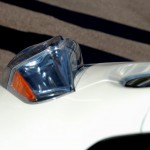 And this is where Nissan and the dowdy-looking Nissan Leaf come in. Maybe dowdy is too harsh, but it’s awkward with a reason. Nissan’s brutal GTR has a drag coefficient of .27. The Leaf, which spent more time in the
And this is where Nissan and the dowdy-looking Nissan Leaf come in. Maybe dowdy is too harsh, but it’s awkward with a reason. Nissan’s brutal GTR has a drag coefficient of .27. The Leaf, which spent more time in the  wind tunnel to fine tune its shape according to the spokesman, manages a drag coefficient if .28, a massive improvement over the .31 of the Nissan Versa on which the Leaf is based on. While not totally outstanding, that is near supercar aerodynamics in a 4 door hatch back. One of the troubles engineers had to deal with was wind noise- While wind noise is a part of regular NVH (Noise, Vibration, Harshness) concerns for gasoline cars, it’s an even bigger concern on the near-silent electric car with the lack of drivetrain noise. The bulbous headlamps on the Leaf play a role in fighting wind noise caused by the mirrors in that they’re raised several inches above the hood-line in order to split the air flow ahead of the mirrors, so that air passes over and under the mirror,
wind tunnel to fine tune its shape according to the spokesman, manages a drag coefficient if .28, a massive improvement over the .31 of the Nissan Versa on which the Leaf is based on. While not totally outstanding, that is near supercar aerodynamics in a 4 door hatch back. One of the troubles engineers had to deal with was wind noise- While wind noise is a part of regular NVH (Noise, Vibration, Harshness) concerns for gasoline cars, it’s an even bigger concern on the near-silent electric car with the lack of drivetrain noise. The bulbous headlamps on the Leaf play a role in fighting wind noise caused by the mirrors in that they’re raised several inches above the hood-line in order to split the air flow ahead of the mirrors, so that air passes over and under the mirror,  instead of into the mirror. Taking advantage of the compact electric drivetrain, the low hood-line smoothly transitions into a laid back windshield, the shape as a whole contributes to the odd styling, but all in the name of aerodynamics. The wheel wells, which are small by today’s standards, house relatively small 16†wheels. The small wheel openings aid in reducing drag, and there are sharp creases along the rear flanks of the Leaf’s fenders, and with the shaped tail lights the design assists in bringing air smoothly away from the car’s rear. All of this is wrapped in Nissan’s new design language, which shares some of its DNA with their Juke. The Toyota Prius and Chevrolet Volt lean towards more conservative styling, but the Leaf is here to stand out.
instead of into the mirror. Taking advantage of the compact electric drivetrain, the low hood-line smoothly transitions into a laid back windshield, the shape as a whole contributes to the odd styling, but all in the name of aerodynamics. The wheel wells, which are small by today’s standards, house relatively small 16†wheels. The small wheel openings aid in reducing drag, and there are sharp creases along the rear flanks of the Leaf’s fenders, and with the shaped tail lights the design assists in bringing air smoothly away from the car’s rear. All of this is wrapped in Nissan’s new design language, which shares some of its DNA with their Juke. The Toyota Prius and Chevrolet Volt lean towards more conservative styling, but the Leaf is here to stand out.
For the tech geeks, the Leaf haz ze teknology. Some of the things worth mentioning are the LED headlamps, which consume less power than standard headlamps. The battery is actually 40 independent cells, each of which can be replaced if malfunctioning instead of the entire battery pack. The pack itself is surprisingly compact, but still heavy at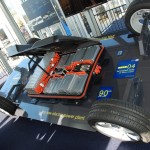 600 lbs. On the plus side, it’s mounted low and centered in the chassis, giving the Leaf a lower center of gravity than a standard car. And most importantly, it does not intrude into the passenger compartment, unlike the Chevy Volt’s T-bar battery which consumes the center of the interior. The interior floor appears to be just the same as it is in a gasoline car, and even still shares the vestigial hump in the center of the rear seat floor, though only an inch or two high.
600 lbs. On the plus side, it’s mounted low and centered in the chassis, giving the Leaf a lower center of gravity than a standard car. And most importantly, it does not intrude into the passenger compartment, unlike the Chevy Volt’s T-bar battery which consumes the center of the interior. The interior floor appears to be just the same as it is in a gasoline car, and even still shares the vestigial hump in the center of the rear seat floor, though only an inch or two high.
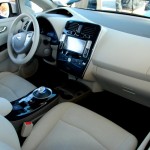 Speaking of the interior, outside of the digital interfaces it’s absolutely nothing to write home about. The dash is hard plastic, but touch points are soft fabric and no better or worse than any other car in the segment, including the Corolla and Civic. I found the armrest to be a little high, and the steering wheel could use more than just up-and-down adjustment, but other than that the ergonomics are quite fine. Seats are softer than expected, but quite welcoming. And Nissan touts that most materials are made from recycled plastics. But, the juicy bits are the unique displays and controls of an electric car. Gone is a tachometer, and in comes an energy meter. Instead of displaying engine RPM, it displays how much electric power is being demanded, or alternatively when coasting how much is being regenerated. A gas gauge is predictably replaced
Speaking of the interior, outside of the digital interfaces it’s absolutely nothing to write home about. The dash is hard plastic, but touch points are soft fabric and no better or worse than any other car in the segment, including the Corolla and Civic. I found the armrest to be a little high, and the steering wheel could use more than just up-and-down adjustment, but other than that the ergonomics are quite fine. Seats are softer than expected, but quite welcoming. And Nissan touts that most materials are made from recycled plastics. But, the juicy bits are the unique displays and controls of an electric car. Gone is a tachometer, and in comes an energy meter. Instead of displaying engine RPM, it displays how much electric power is being demanded, or alternatively when coasting how much is being regenerated. A gas gauge is predictably replaced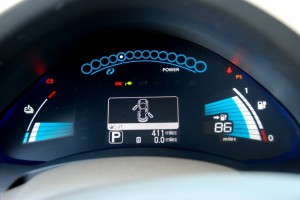 by a battery meter, but unexpectedly is the coolant temp being replaced with a battery temp gauge. The standard PRND is replaced with a toy-like selector that pivots around 4 different positions. Center is where the shifter sits when released, moving it left and up selects reverse, moving it left and down selects drive (selecting drive again engages or disengages ECO mode), and simply moving it left selects neutral. Pressing the top button in the selector’s resting position engages park. It sounds more complex than it really is, and comes across as little more than a joy stick to select a gear. The parking brake handle is replaced with a pull-up button that electronically engages the brake. This is an electric car, everything has to be different somehow, right? Thankfully the center cluster is conventional by all means, and with in easy reach.
by a battery meter, but unexpectedly is the coolant temp being replaced with a battery temp gauge. The standard PRND is replaced with a toy-like selector that pivots around 4 different positions. Center is where the shifter sits when released, moving it left and up selects reverse, moving it left and down selects drive (selecting drive again engages or disengages ECO mode), and simply moving it left selects neutral. Pressing the top button in the selector’s resting position engages park. It sounds more complex than it really is, and comes across as little more than a joy stick to select a gear. The parking brake handle is replaced with a pull-up button that electronically engages the brake. This is an electric car, everything has to be different somehow, right? Thankfully the center cluster is conventional by all means, and with in easy reach.
 What is unique is when you press the “Zero Emissions†button, which brings up an array of menus on the Leaf’s LCD screen related to the electric drive and charging systems. The Leaf has taken a page out of the GTR’s wizardry, giving more bar graphs, detailed information, and charging options than the average person would know what to do with. However, like the GTR, this information is directed solely for the intended enthusiasts. G-Meters and 0-60 timers are replaced with energy consumption dials, detailing power usage by the motors, accessories like radio and climate control, and finally “other systems,†whatever those maybe. It shows real time how using the various accessories affect the range. Another nifty feature is the programming that one can apply to the Leaf. Not only can you tell it to only charge between certain hours, in order to take advantage of off-hour rates, but also when to automatically kick on the heater or A/C at a set time so that the interior is at-temp before you get into the car, eliminating the need to split the energy between both systems while driving. Another adaptation for the electric car is what is displayed on the GPS. The map has a pair of circles, which show the Leaf’s range overlaid the map. The inner circle shows the low-ball estimate of the car’s range, and the outer circle shows the outer reaches of the range. A quick zoom out quickly demonstrates how much ground can be
What is unique is when you press the “Zero Emissions†button, which brings up an array of menus on the Leaf’s LCD screen related to the electric drive and charging systems. The Leaf has taken a page out of the GTR’s wizardry, giving more bar graphs, detailed information, and charging options than the average person would know what to do with. However, like the GTR, this information is directed solely for the intended enthusiasts. G-Meters and 0-60 timers are replaced with energy consumption dials, detailing power usage by the motors, accessories like radio and climate control, and finally “other systems,†whatever those maybe. It shows real time how using the various accessories affect the range. Another nifty feature is the programming that one can apply to the Leaf. Not only can you tell it to only charge between certain hours, in order to take advantage of off-hour rates, but also when to automatically kick on the heater or A/C at a set time so that the interior is at-temp before you get into the car, eliminating the need to split the energy between both systems while driving. Another adaptation for the electric car is what is displayed on the GPS. The map has a pair of circles, which show the Leaf’s range overlaid the map. The inner circle shows the low-ball estimate of the car’s range, and the outer circle shows the outer reaches of the range. A quick zoom out quickly demonstrates how much ground can be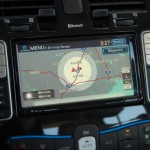 covered on a charge, and it’s a bit of a surprise at just how far you can go on this glorified golf cart. It can also update regularly with new charging locations, and display those on screen. And, as you run the battery lower and lower, it will eventually default the GPS to show local charging stations in a passive attempt at getting you to juice it up. And you can kill it dead, there’s no back-up battery to save stupidity. There is relief though, that most major cities plan to put in place charging stations at major stores, fastfood joints, and businesses so that the car can be charged while you’re out and about. Even 440v DC “Fast chargers” are an option so that the car can be charged from 0%-80% in roughly 25 minutes. These will even be placed between various cities so that cars like the Leaf can run on longer trips, albeit with a 20 minute break during the trip. This almost sounds like a deal breaker, while keeping in mind that the Leaf is meant to be a commuter car, much of the “range anxiety” can be relieved by changing how you treat a “fill up,” meaning unlike a gas car where it’s no problem to run it down near empty and refill it, it’s a good habit to top-off the Leaf where ever it can charge.
covered on a charge, and it’s a bit of a surprise at just how far you can go on this glorified golf cart. It can also update regularly with new charging locations, and display those on screen. And, as you run the battery lower and lower, it will eventually default the GPS to show local charging stations in a passive attempt at getting you to juice it up. And you can kill it dead, there’s no back-up battery to save stupidity. There is relief though, that most major cities plan to put in place charging stations at major stores, fastfood joints, and businesses so that the car can be charged while you’re out and about. Even 440v DC “Fast chargers” are an option so that the car can be charged from 0%-80% in roughly 25 minutes. These will even be placed between various cities so that cars like the Leaf can run on longer trips, albeit with a 20 minute break during the trip. This almost sounds like a deal breaker, while keeping in mind that the Leaf is meant to be a commuter car, much of the “range anxiety” can be relieved by changing how you treat a “fill up,” meaning unlike a gas car where it’s no problem to run it down near empty and refill it, it’s a good habit to top-off the Leaf where ever it can charge.
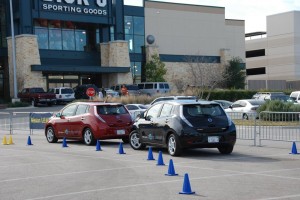 Introductions aside, it’s time to drive. Coming into this, it must be said that I drove to the event in a 1969 Chevrolet CST/10 pickup. It’s loud, rough, and has enough 40 year old components remaining that it shakes, rattles, and rolls down the road with quite a presence. I get into a Leaf, adjust my seat, and start to poke around for the “start†button when I’m told it’s already running. I know this is an electric car, but it’s still…odd… to hear nothing. When you do actually “start” the car, it does play a little juke while lighting up the gauge cluster to let you know that it’s actually on. The throttle is a bit spongy at low speed, but the Leaf’s instant 200 ft lb of torque makes its presence known if you dive deeper into the throttle. It’s an experience unlike any other car. Even though it’s an electric car, you can find an excuse for traction control at speeds where most 4 bangers are still building steam. Off the line it surges with authority, and thanks to the lack of a transmission, it steams right on up with an uninterrupted, slightly sci-fi soundtrack from the electric motor. No peaking power bands, no shifting… Just forward. And during all of this, the Leaf is beautifully smooth, quiet and dare I say; graceful. During cruising you’re more likely to hear the hum of the A/C blower motor than you are of the drivetrain. Wind noise is well controlled, an achievement that the reps were very proud of. It’s a level of cabin noise that’s surely lower than the best luxury cars, an interesting side effect to the electric drivetrain. It may still use a dated suspension, but the ride is well controlled and the handling is surprisingly quite precise and a little tossable thanks to the low center of gravity.
Introductions aside, it’s time to drive. Coming into this, it must be said that I drove to the event in a 1969 Chevrolet CST/10 pickup. It’s loud, rough, and has enough 40 year old components remaining that it shakes, rattles, and rolls down the road with quite a presence. I get into a Leaf, adjust my seat, and start to poke around for the “start†button when I’m told it’s already running. I know this is an electric car, but it’s still…odd… to hear nothing. When you do actually “start” the car, it does play a little juke while lighting up the gauge cluster to let you know that it’s actually on. The throttle is a bit spongy at low speed, but the Leaf’s instant 200 ft lb of torque makes its presence known if you dive deeper into the throttle. It’s an experience unlike any other car. Even though it’s an electric car, you can find an excuse for traction control at speeds where most 4 bangers are still building steam. Off the line it surges with authority, and thanks to the lack of a transmission, it steams right on up with an uninterrupted, slightly sci-fi soundtrack from the electric motor. No peaking power bands, no shifting… Just forward. And during all of this, the Leaf is beautifully smooth, quiet and dare I say; graceful. During cruising you’re more likely to hear the hum of the A/C blower motor than you are of the drivetrain. Wind noise is well controlled, an achievement that the reps were very proud of. It’s a level of cabin noise that’s surely lower than the best luxury cars, an interesting side effect to the electric drivetrain. It may still use a dated suspension, but the ride is well controlled and the handling is surprisingly quite precise and a little tossable thanks to the low center of gravity.
 And it creates quite the proposition for future drivetrains. Here we have a $25,000 car with NVH levels competitive with cars twice its cost. A premium experience, in this regard. Without pistons violently thrusting up and down and transmissions jumping through gears it provides smooth thrust that will never be matched by a piston engine. Not even a CVT can provide the smooth responsiveness that the direct-drive electric motor gives. It gives a small car a level of refinement that manufacturers can only dream of with a gas engine, especially to the bread-and-butter cars. To the average consumer there’s less maintenance to worry about; there’s no oil to change, emissions systems to inspect, or cooling systems to worry about. Brakes are even given a lengthy life span thanks to their job being shared with the regenerative braking/charging system. In the future land of beige, it’s easy to see electric cars cross-shopped with Corollas, Cruises, and Civics. Its price is competitive with them, for instance to get the options that you get in the Leaf, a comparable 2011 Honda Civic runs the MSRP of just under $25,000. And other than out-right range, it just does everything better than they can. With all off this, and the fact that you’ll never buy gas for the damn thing, it starts to make sense, even financially. The current short comings of electric cars are solvable problems in time. Nissan has committed to designing the battery pack to be replaceable with future innovations, and designing the unit so that future Nissan EVs with more advanced batteries can have their guts transplanted into the Leaf, keeping older models relevant in 5-10 years.
And it creates quite the proposition for future drivetrains. Here we have a $25,000 car with NVH levels competitive with cars twice its cost. A premium experience, in this regard. Without pistons violently thrusting up and down and transmissions jumping through gears it provides smooth thrust that will never be matched by a piston engine. Not even a CVT can provide the smooth responsiveness that the direct-drive electric motor gives. It gives a small car a level of refinement that manufacturers can only dream of with a gas engine, especially to the bread-and-butter cars. To the average consumer there’s less maintenance to worry about; there’s no oil to change, emissions systems to inspect, or cooling systems to worry about. Brakes are even given a lengthy life span thanks to their job being shared with the regenerative braking/charging system. In the future land of beige, it’s easy to see electric cars cross-shopped with Corollas, Cruises, and Civics. Its price is competitive with them, for instance to get the options that you get in the Leaf, a comparable 2011 Honda Civic runs the MSRP of just under $25,000. And other than out-right range, it just does everything better than they can. With all off this, and the fact that you’ll never buy gas for the damn thing, it starts to make sense, even financially. The current short comings of electric cars are solvable problems in time. Nissan has committed to designing the battery pack to be replaceable with future innovations, and designing the unit so that future Nissan EVs with more advanced batteries can have their guts transplanted into the Leaf, keeping older models relevant in 5-10 years.
However, there must be time taken to look at it from an environmental approach. And to me, it’s one that has few grounds to stand on. While electricity has the advantage of being DIRT CHEAP (Even if gas was under 1.50/gallon, the cost to run the Leaf off your house is still cheaper, according to Nissan’s statistics), it’s not clean energy for the majority of the US. Roughly 48% of our electrical energy comes from coal. Only 7% comes from renewable resources, such as wind or hydroelectric power. Ever notice that any Nissan advertisement with Zero Emissions* has an astric? Their ad campaign is built on the fact that there are zero *tailpipe emissions. While you do have to consider the lack of pollutants being burned by the car, it must be said that it’s not free and clear from pollution. Granted, the extra demand for electricity from the cars will be insignificant for now, and the expansion of cleaner energy such as nuclear, and fuel cell technology in the future can be the better answer to that problem. The batteries are a point of scrutiny in most cars, but Nissan claims that they are recyclable, and even if the cells become too weak for automotive use, they can still be used for stationary applications as energy storage. One last point of contention on Lithium Ion batteries is the fact that the materials have to be mined. Keep in mind, so does the material for your cell phone, iDoodad, laptop, and high-performance R/C car. We’re already mining the materials, it’s wrong to scrutinize the electric car battery when lithium already powers an array of other devices in our lives.
electricity has the advantage of being DIRT CHEAP (Even if gas was under 1.50/gallon, the cost to run the Leaf off your house is still cheaper, according to Nissan’s statistics), it’s not clean energy for the majority of the US. Roughly 48% of our electrical energy comes from coal. Only 7% comes from renewable resources, such as wind or hydroelectric power. Ever notice that any Nissan advertisement with Zero Emissions* has an astric? Their ad campaign is built on the fact that there are zero *tailpipe emissions. While you do have to consider the lack of pollutants being burned by the car, it must be said that it’s not free and clear from pollution. Granted, the extra demand for electricity from the cars will be insignificant for now, and the expansion of cleaner energy such as nuclear, and fuel cell technology in the future can be the better answer to that problem. The batteries are a point of scrutiny in most cars, but Nissan claims that they are recyclable, and even if the cells become too weak for automotive use, they can still be used for stationary applications as energy storage. One last point of contention on Lithium Ion batteries is the fact that the materials have to be mined. Keep in mind, so does the material for your cell phone, iDoodad, laptop, and high-performance R/C car. We’re already mining the materials, it’s wrong to scrutinize the electric car battery when lithium already powers an array of other devices in our lives.

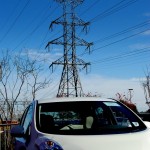 So what does this mean for the piston engine? It means nothing in the short run, but maybe everything in the long run. The electric car is just moving past the point of being a novelty; it’s now a legitimate player. It’s the birth of a new era for the automobile, one that’s deprived of cam shafts, valves, pistons, and gasoline. It’s strange to think that there is going to be a time where the familiar exhaust note is nowhere to be found in new cars. And in part it’s because the electric motor can accomplish everything we want piston engines to do; flat torque curve, smooth power delivery, low noise, low maintenance, efficiency and low center of gravity. As time progresses, outright performances gets better and better as well (Fisker and Tesla want to show you). While the source of power may change and evolve (to one that doesn’t rape the land for battery materials with the impression of environmental goodness), the electric drivetrain is going to make its comeback over the next century.
So what does this mean for the piston engine? It means nothing in the short run, but maybe everything in the long run. The electric car is just moving past the point of being a novelty; it’s now a legitimate player. It’s the birth of a new era for the automobile, one that’s deprived of cam shafts, valves, pistons, and gasoline. It’s strange to think that there is going to be a time where the familiar exhaust note is nowhere to be found in new cars. And in part it’s because the electric motor can accomplish everything we want piston engines to do; flat torque curve, smooth power delivery, low noise, low maintenance, efficiency and low center of gravity. As time progresses, outright performances gets better and better as well (Fisker and Tesla want to show you). While the source of power may change and evolve (to one that doesn’t rape the land for battery materials with the impression of environmental goodness), the electric drivetrain is going to make its comeback over the next century.
 The 20th century will always be the rise of the gasoline engine. Maybe the 21st will be the rise of the electric motor.
The 20th century will always be the rise of the gasoline engine. Maybe the 21st will be the rise of the electric motor.
Popularity: 8% [?]




Comments on this entry are closed.